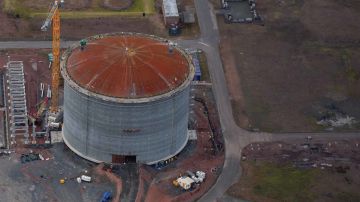Global demand for energy has been rising ever since the 18th century when mankind started using the earth’s natural resources to fuel the Industrial Revolution. It brought great change across the world. But the recent rapid industrialisation of countries like India and China continues to fuel a further huge increase in demand. So what does the future hold?
THE demands for global energy are unlikely to trouble the average man or woman in the street.
But Governments, scientists, academics, environmentalists and energy-intensive companies like INEOS are continually looking at improving energy efficiency. It’s a major concern.
Fossil fuels currently feed manufacturing plants around the world, where tons of chemicals are manufactured every day so that others can produce everything from paints to plastics, medicines to mobile phones and cars to clothing.
“Many of the problems that threaten mankind’s survival on the planet results from the increased consumption of energy, water and raw materials,” said a spokesman for Friends of the Earth Europe.
So what are the alternatives? Could wind farms and harnessing the sun’s power hold the answers?
Yes, say Friends of the Earth Europe.
In part, says INEOS. They are part of the energy mix but they won’t meet mankind’s needs all the time.
It will take decades, however, to fully transform how Europe generates electricity and heat, so in the interim INEOS has to rely on fossil fuels to meet its energy needs. But gas has around half the emissions of coal, so INEOS believes it has an environmental duty to encourage a move towards gas rather than coal.
Renewable technologies are important customers of INEOS. INEOS make the raw materials that go into wind turbines and into solar cells. Raw materials that are made from the molecules we get from gas.
“Gas is needed in the long-term as a raw material to underpin manufacturing” says Leen Heemskerk, Chief Financial Officer of INEOS Olefins & Polymers Europe (North).
Gas is not just a fuel that INEOS burns for energy. t is also a raw material used in the manufacture of chemicals that have application in a wide range of essential products including medicine, clothing, buildings, vehicles, computers, and green technologies, such as wind turbines and energy efficient materials.
INEOS will still need gas to make these essential items once it has made the transition to low-carbon energy. It is vital, therefore, that Europe has a secure and competitive long-term supply of gas to underpin the future of the manufacturing sector.
“INEOS support the innovation drive to find alternative energy sources but we need to be realistic at what pace we can de-carbonise our economy,” said Leen.
The world currently consumes about 529 quadrillion British thermal units every year. Fossil fuels currently supply nearly 80% of the world’s energy. And industry, which supplies the products on which society depends, is its biggest customer.
America, with just 5% of the planet’s population, currently consumes about 20% of the world’s total energy supply.
But the global demand for energy is expected to double by 2040 as people in India and China, which between them contain more than a third of the planet’s people, get richer and want more energy-consuming goods such as computers.
Environmentalists say society must change its ways if it is to avoid an energy crisis and have a hope of averting climate change.
Increased regulation and restrictions on greenhouse gases, have helped, they say.
But Friends of the Earth Europe believes wealthy nations also need to cut down on the amount of energy consumed.
So too does the European Commission.
It is setting ambitious targets for Europe that could ultimately force industry to drastically cut down on the amount of energy it uses.
INEOS argues that this could have unintended consequences, including a shift of investment and a growth of industry outside of europe.
“There is a very big misunderstanding of the chemical industry,” said Greet van eetvelde, INEOS Manager of Cleantech Initiatives. “We are energy intensive but we are not energy inefficient. We are continually looking at ways to reduce the amount of energy we use to produce our products. It makes good business and environmental sense. But we are also carbon intensive. We use those gas molecules as raw materials. We still have got a long way to go before the officials understand what we are about. To them, industry is just industry. But the process industry is different, and without the chemical industry in particular, modern life would not be possible.”
Dan Byles, chairman of the UK Government’s All Party Parliamentary Group for Unconventional Oil and Gas, said it was not whether the world wanted low carbon energy that was in question. “It is the pathway to getting there,” he said. “Gas must be seen as a bridging fuel between an energy system still dominated by oil and coal and the low carbon future energy mix that we all want to see.”
He argued that a choice should not be forced between gas or renewables. “We need both,” he said. “And we will do for some time.”
Coal – the worst offender – has fuelled China’s meteoric rise from a small, emerging market into the second biggest economy in the world. But it’s come at a huge cost to the environment, with China now emitting more CO2 than any other country in the world.
Last year China’s dependence on coal fell for the first time this century and was coupled with a rapid increase in the use of renewable energy.
That, said Greenpeace east Asia, gave the planet a ‘window of opportunity’.
“The significance is that if the coal consumption growth we have seen in China in the last 10 years went on, we would lose any hope of bringing climate change under control,” said Lauri Myllyvirta, energy campaigner at Greenpeace east Asia. “It may not be the peak yet but it is a sign that China is moving away from coal.”
Alternative energy sources need to be found because, as the world’s population grows, so too will the demand for energy.
In the developed world, access to safe, reliable and affordable energy has transformed people’s lives – and it could do the same for those living in the poorest places in the world.
One who wants to see that happen is Microsoft founder Bill Gates, one of the richest men on earth.
“In the rich world, we are right to worry about conserving energy, but in poor places, people need more energy,” he wrote in a recent blog. “For countries to lift themselves out of poverty, they need lights in schools so students can study when in the dark, refrigerators in health clinics to keep vaccines cold and pumps to irrigate farmland and provide clean water.”
Mr Gates said the onus was now on wealthy countries like the US to invest more in research into clean energy.
“It’s about developing energy sources that produce zero carbon,” he said.
The chemical industry, although it consumes much of the world’s energy supply, is at the heart of many of those developments – and is helping to decarbonise the world economy.
Global emissions have been cut thanks to improvements – driven by the chemical industry – in insulation materials for the construction industry, chemical fertilisers and crop protection, plastic packaging, lighting, marine anti-fouling coatings, synthetic textiles, automotive plastics, low-temperature detergents, engine efficiency, and plastics used in piping.
“These savings highlight the vital role of the chemical industry in decarbonising the economy,” said a spokesman for the International Council of Chemical Associations. “In reality, achieving the equivalent CO2 savings without the benefits of chemical products and technologies would not be possible.”
The use of chemistry in energy-saving products, such as building insulation, compact fluorescent lighting, and lightweight plastic vehicle parts, saves America alone up to 10.9 quadrillion Btus of energy and up to $85 billion in energy costs annually.
In layman’s terms, that means the US has cut its energy consumption by 11% and has saved the energy needed to power 135 million vehicles for a year.
“That is 55% of all the cars on the road today,” said Ryan Baldwin, spokesman for the American Chemistry Council.
The International Council of Chemical Associations said recently that chemical products for vehicles were now saving 230 million tons of greenhouse gas emissions every year.
And INEOS is at the heart of many of the advances being made by manufacturers to make cars lighter, stronger and more fuel efficient. Plastic is one. Carbon fibre is another. But there are also a host of other raw materials made by INEOS that are finding their way into fuel efficient tyres, and synthetic oils that are improving engine efficiency.
INEOS also manufactures components for wind turbine and products for the solar industry. In short, it is enabling other industries – the renewables sector – to save energy and cut CO2 emissions.
The transition to renewables, though, is unlikely to happen overnight because, although the renewable sector is growing, it is not growing fast enough and the available green technologies do not generate enough energy all the time to meet the demand.
The National Academies, advisers to America on science, engineering and medicine, says reducing the amount of energy lost is as important to our energy future as finding new sources.
“Gigantic amounts of energy are lost every minute of every day in converting it into a useable form,” said a spokesman.
That, too, is an area in which INEOS works creatively. It has to, if it wants to stay in business in Europe where the cost of energy is now twice as high as it is in America.
“We have got to continually maximise our energy efficiency,” says Jean-Noel Large, who has been given the job of improving the efficiency of the Petroineos at Lavera in France. “It is up there with the safety of the site.”

















